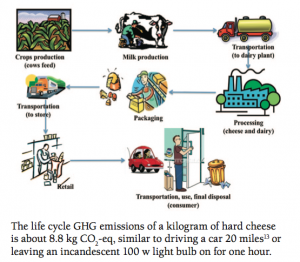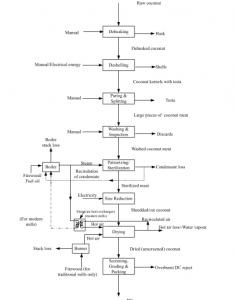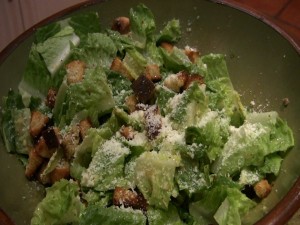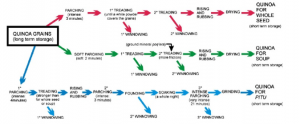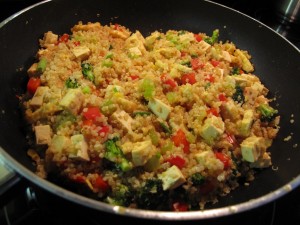Breakfast: For breakfast this morning, I got up and decided to make an egg scramble in an attempt to clear out the fridge. Along with 2 eggs, I sautéed some fresh onion, peppers and tomatoes and topped the whole scramble off with a sprinkle of parmesan cheese. To finish it off, I brewed a fresh cup of coffee, here is a breakdown of the ingredients and where they came from:
- 2 eggs and parmesan cheese: East end food co-op, Eggs- Maple Hill Farms (Abbotsford, BC), cheese-?
- Onion, peppers, tomato: Kitsilano farmers market, Cropthorne Farms (Ladner, BC)
- Coffee: Donald’s market, Best Gourmet coffee (“All our coffees come from a single documented origin and are regulated by appropriate international councils…grown within 10 degrees of the equator” -> ?)
Because all the ingredients to my breakfast (aside from coffee and potentially the cheese) were sourced from local, BC farmers, I can at least clear my conscience that not a lot of oil was needed to physically bring the food to my table. I try to eat locally and organically as much as I can to both minimize the impact of my eating on the planet and reap the health benefits. The produce found its way to my table by travelling about 30 kms by truck to the Kitsilano farmers market, where it exchanged ownership free of packaging and into my backpack to be biked home. The eggs had a slightly longer route 65 kms from Abbotsford to Commercial Drive in recycled paper egg crates before reaching my fridge.
From looking into the farming practices of Maple Hill farms, the eggs I ate were, although free range, the product of hens on vegetable based diets. Their website mentions the use of a grain/vegetable based ration for the hens. I called Morgan at the farm and asked her about where they get their rations and she mentioned it comes from local feedlots. However, this does not change the fact that the grain, although local, is likely produced on fertilizer rich, oil-hungry agricultural land, but at least it has less far to travel!
Cropthorne farms is a local producer of produce situated on Westham Island, just 30 kms away. They are a certified organic farm, so the impact of their farming on their surrounding environment is less harsh than other large corporate-owned farms that mass produce a single crop. The farm is run by two sisters who use both human and machine power to plant, maintain and harvest their mix of crops. They do employ the help of a tractor in order to speed things up a little, which uses diesel fuel to power it’s engine. They make around $40,000 per acre at the Cropthorne farm, far from the average $200 per acre many massive wheat farms make in the prairies. The farm has made low-impact agriculture successful monetarily and hopes to encourage other young folks interested in farming to follow their small-scale example. I found an interesting article with an interview with one of the sisters here.
Although I was not able to source the exact location of the beans used in my “Gourmet” coffee, it says on their website that all beans are grown within 10 degrees of the equator. This means that regardless of where they are grown (when I called the company they said a mix of South American, African and Asian beans are used in my particular “French” blend) they have a long way to go before reaching Maple Ridge. Given that the coffee was likely grown on a conventional plantation where high profits are the primary concern, a lot of oil was probably used in it’s production. First, in order to clear an area for the coffee plants to be planted, massive machinery would have to be used for deforestation. Then, in order to speed up the growing cycle and increase crop yields, a nitrogen-rich fertilizer (that may or may not be banned in “developed countries”) would be applied to the crops. After hand-harvesting the beans (as it is economically feasible due to low wages in coffee-growing countries) they would probably be sent to high volume production facilities where the bean is processed to remove the pulp. Coffee production is one of the most detrimental processes to the natural environment when factoring in the effects of deforestation, soil erosion, waste water production and CO2 released, I have to say from reading about its effects, I want to cut the habit out of my diet as I had no idea how much pollution is released in such a seemingly simple process. The amount of processing that goes into removing the “cherry” from the coffee plant so that it can then be roasted and eventually packaged for sale can be seen here.
 My eggs don’t look so local now…
My eggs don’t look so local now…
Lunch: For lunch I decided to make my usual go-to, caesar salad and a toasted bagel with avocado. Easy to make, yummy and filling, I make this quick lunch often with the following ingredients:
- Caesar salad:
- Lettuce and onions- Kitsilano Farmers Market, Cropthorne Farms (Ladner BC)
- Croutons and dressing: No Frills, President’s Choice brand, ?
- Parmesean Cheese: East End food market, ?
- Bagel with Avocado:
- Bagel: No Frills, Country Havest Bagels (“Made with 100% Canadian wheat”)
- Avocado: East-end Food Co-op, West Pak (California)
- Drink: Young Coconut juice, East-end Food Co-op, La Natural (Philippines)
In terms of the arrival of these foods to my table, all were in biking area of my neighbourhood and thus did not contribute to any additional burning of fossil fuels in order to be enjoyed! To get these foods into the retail locations that allowed me to buy them for my enjoyment is another story. The milage that these finished edibles had to travel would have added serious CO2 to the atmosphere coming from all directions, my coconut juice alone made a 10,500 kilometer trek to my table.
The least sustainable parts of this meal were the highly processed and packaged foods (croutons, bagels and coconut juice), which for health reasons I try to minimize my intake of. The croutons alone have: Wheat flour, sunflower and/or canola oil (contains citric acid, tocopherols), seasoning (whey, sea salt, parmesan cheese, dehydrated garlic and onion, worcestershire sauce powder, buttermilk solids, natural flavour, spices, sodium phosphate, citric acid, salt, malic acid, disodium phosphate), yeast, water, salt, wheat gluten, natural flavour, fumaric acid, sodium diacetate, lactic acid, ascorbic acid, malted barley flour.
Turning wheat into flour that can be used in processed foods is not a easy task. From raw plant material, it must pass through 16 steps before it is able to be consumed by humans, and even then it must undergo some sort of cooking before it can be digested by the body. The process is extremely energy intensive and although I cannot find figures on the precise amount of oil used, it is interesting to note that in order to make ONE loaf of bread, 31 square feet of wheat must be harvested. 31 square feet for one loaf of bread! There is a good video that explains precisely the steps raw wheat goes through in order to become flour, which also shows the huge amount of machinery used in the process.
The parmesan cheese from East-End food market, although I cannot find out exactly where it is from, I can assume underwent a good deal of processing and consumed a lot of oil in it’s creation. I found out that modern dairy practices produce about 1.2 lbs of CO2/lb of milk. So, in order to make me 1 lb of cheese, because 10 lbs of milk are needed, around 12 lbs of CO2 were released into the atmosphere. Because I was eating parmesean cheese, there is the aging process that must be factored in as well, as parmesean and other dry aged cheeses must sit in a refrigerated area to dehydrate for awhile before they reach maturity. I found this nice diagram to illustrate the process cheese goes through when being made and how each step contributes CO2:
FInally, my coconut juice. I could not find much information on the unique farming practices of “La Natural” so I looked into the manufacturing process for other popular coconut juices. I found this diagram of the manufacturing process:
As you can see from the above, the conversion of coconut from raw materials to a drinkable liquid is energy intensive both mechanically and manually. The biggest source of environmental damage in this process does not come from CO2 emissions, although I found that the average coconut mill in Sri Lanka (which I would imagine would be similar to the Philippines) emits 72, 500 tons of CO2/year! The most detrimental damage is caused by the wastewater that is not properly integrated back into the ecosystem and therefore causes serious damage to vegetation, ground water resources and water bodies. In addition to the processing of the juice, the packaging for the juice came in a single serving can. For this can to be manufactured, then shipped to the packaging plant for the coconut juice and then shipped to Canada would have added a lot of oil usage to the production of my meal.
looking at this image now, I feel guilty about being too lazy to plant my own garden this year 🙁
Snack: Peach from East-end Food co-op
This peach made its way up to the East-end Food coop from California, where approximately 70% of BC’s produce is grown. It would have likely travelled over 1000 miles in a cooled freight truck before ending up on my table.
Dinner: I made a healthy and relatively easy to make quinoa stir fry, another one of my favourite dishes to whip up. That along with a cold beer made up the remainder of my food intake for the day, it contained the following:
- Quinoa Stir Fry:
- Tofu: East end food coop, Sunrise Soya Foods (Toronto, ON)
- Quinoa: Donald’s Market, Dan-D-Organics
- Peppers, Onion, zucchini, mushrooms: Kitsilano Farmers Market, Cropthorne Farms
- Broccoli: East End Food Co-op, California
- Sauce: Schezwan sauce, No Frills, President’s choice brand
- Beer: Cariboo Genuine Lager, BC Liquor Store (Prince George, BC)
Because I have already talked about much of the origins of the produce I have eaten over the course of the day, I will focus only on the beer, quinoa and the sauce.
First of all, the beer. Cariboo, like many other lagers in brewed from malt, water, yeast and hops. Each of these (well, I guess apart from the water) must be processed in a plant outside of the Cariboo brewery in Prince George. They are all then shipped to the brewery independently where they are mixed and left to ferment in huge vats that must be kept at cool temperatures in an air conditioned factory. All of this requires huge amounts of oil for both the transportation and factory temperature control. In order to make malt alone, barley must be grown on large industrial farms and then shipped to processing plants. This uses a lot of fertilizer, farm equipment and fossil fuels to run the heavy equipment. When it is being processed, it undergoes steeping, germination, turning and kilning, which each require the operation of a separate machine powered by electricity. In the seeping process, although the respiration is not substantial, the barley actually expels CO2 as well!
The quinoa from Dan-De-Organics originates from Bolivia, a large exporter of the “super grain” that has gained popularity in previous years with Western health enthusiasts. Because it grew in popularity so quickly, many farmers switched crops on their land to plant this higher profit crop at the cost of fragile local ecosystems. Most quinoa headed for the Americas (Dan De Organics is from Richmond BC) is harvested by hand and therefore does not require much oil to run heavy farming machinery. As well, because most quinoa is organic, there is not heavy nitrogen-rich fertilizers used in it’s growth cycle. However, because the plant is fairly new to the stresses of corporate farming, some environmentalists are worried of the long-term effects of quinoa farming on the land, where there is already recorded soil erosion and wastewater damage to neighbouring ecosystems. The grain does go through the following process in order to be edible and ready for shipping to North American markets:
The quinoa is also packaged in a plastic wrapper, made similarly to plastic bags, which is a notoriously energy intensive process using ethylene (a derivative of natural gas and petroleum) as a primary raw material. So much oil!
Finally, the Szechwan sauce. Szechwan sauce, as made by president’s choice, contains: Rice wine vinegar, peanuts, brown sugar, soy sauce (water, wheat, soybeans, salt), canola oil, honey, sesame oil, ginger, dehydrated garlic, spices, xanthan gum, spice extracts.. Obviously another highly processed food. Rice is another massively produced agricultural product that accounts for 10% of all fossil fuel emissions arising from agricultural practices. On one website, it was stated that around 33% of greenhouse gas effects arise from our food production system, so this 10% from growing rice has a fairly sizeable effect. Rice farming has such a negative reputation because of the methane emissions that are released after soil is submerged in water for four months of the year. Because of the unique growing conditions required for rice to prosper, there has been much damage done to the natural environment in order to make space for rice crops. This includes: increased surface run-off, topsoil loss, erosion and decreased terrestrial root zone diversity. These negative externalities have increased the need to apply fertilizers and pesticides to rice fields, thereby increasing the negative damage to the surrounding environment.
A staple of my 10,000 mile diet
Conclusion:
Altogether this assignment has definitely heightened my awareness of the use of oil in the food that I eat on a daily basis. Although I think that I am fairly aware and actively decide to avoid certain types of food that I know are grown in ways that damage the environment, learning more about the few processed foods that I do eat makes me want to cut them out of my diet completely!
Works cited:
“Aluminum: The Element of Sustainability.” Aluminum Association. Sept 2011: n. page. Web. 12 Jul. 2013. <http://aluminum.org/Content/ContentFolders/Miscellaneous/Aluminum_The_Element_of_Sustainability.pdf>.
“Desiccated coconut industry of Sri Lanka: opportunities for energy efficiency and environmental protection.” Pergamon. 13 10 2001: n. page. Web. 12 Jul. 2013. <http://www.faculty.ait.ac.th/visu/smi_roadmap/Publications/Journal_Articles/DC_Paper-Full.pdf>.
Flores, Paola. “Quinoa Boom Puts Stress On Bolivian Economics, Environment .” Huffington Post. 20 02 2013: n. page. Web. 12 Jul. 2013. <http://www.huffingtonpost.com/2013/02/20/quinoa-boom-bolivian_n_2724251.html>.
Green Commodities Facility, . “Sustainable Rice Production Systems: Scoping Paper.” UNITED NATIONS DEVELOPMENT PROGRAMME. Mar 2010: n. page. Web. 12 Jul. 2013. <http://www.greencommodities.org/attachments/124_UNDP Green Commodities Facility _Rice Scoping Paper.pdf>.
Lopez, Laura. “Traditional post-harvest processing to make quinoa grains( Chenopodium quinoa var. quinoa ) apt for consumptionin Northern Lipez (Potosí, Bolivia): ethnoarchaeologicaland archaeobotanical analyses.” Archaeol Anthropol Sci. 2011: n. page. Web. 12 Jul. 2013. <http://academia.edu/923289/Traditional_post-harvest_processing_to_make_quinoa_grains_Chenopodium_quinoa_var._quinoa_apt_for_consumption_in_Northern_Lipez_Potosi_Bolivia_ethnoarchaeological_and_archaeobotanical_analyses>.
Nordy, Waney. “Traditional versus intensive Coconut Production in North Sulawesi.” Sam Ratulangi University Faculty of Agriculture. 2002: n. page. Web. 12 Jul. 2013. <http://www.stanford.edu/group/FRI/indonesia/research/coconutreport.pdf>.
Paul, Chefurka. “Connecting the Dots: Food, Fossil Fuel and Population.” 31 Jan 2011: n. page. Web. 12 Jul. 2013. <http://www.paulchefurka.ca/Food_Energy.html>.
Richard, Manning. “The Oil We Eat .” Harper’s Magazine. Feb 2004: n. page. Web. 12 Jul. 2013. <http://search.proquest.com.ezproxy.library.ubc.ca/docview/233478610?accountid=14656>.
“Understanding the Carbon Footprint of Cheese.” Sustainable Cheese Production. 2008: n. page. Web. 12 Jul. 2013. <http://clean-water.uwex.edu/pubs/pdf/CF-Cheese.pdf>.
